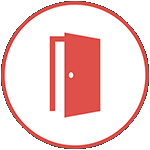Hitting the Road: Now is the Time to Market Your City
Industry analysts are calling the impact of COVID-19 “The Great Travel Depression,” especially for airlines and hotels. In fact, the travel economy measured 81% below last year’s levels for the week ending June 6, registering a $19 billion loss compared to the same week last year.
Kentucky is not immune to the tourism dive. The U.S. Travel Association tracks weekly metrics. Since April, Kentucky has seen weekly changes as dramatic as a 91% decrease over the same week a year ago (the week of the Kentucky Derby) in travel spending.
But it’s turning around. The good news for Kentucky is that the lingering reluctance to travel far from home and spend on expensive trips means that more people are looking for alternative day trips and weekend getaways. Moreover, they are looking for safe environments, especially the great outdoors. That means that Kentucky cities, with waterways, trails and many other natural assets, are inviting destinations.
Roger Brooks of the Destination Development Association is a downtown development and community branding expert. He says that now is prime time for smaller, more rural cities to ramp up their marketing to locals looking for “staycations” as well as people interested in day or weekend trips. Brooks, who has spoken at three KLC conferences in the past, defines a day trip as less than 45 minutes in travel, and he defines a typical overnight or weekend trip as two to two-and-a-half hours of travel. If your city wants to market its amenities, thinking about people in those travel ranges is a good place to start.
Whether or not your tourism office is part of the city, tourism-related revenues are important.
Market What?
The first step is to consider your assets based on what people want right now. They want to get out of the house and get their children out of the house. Even though schools have started back in many areas, families are more flexible and are looking for options. People want to be in a safe, clean environment - and they also want to reconnect with family and friends they have not seen in months. Places that provide outdoor experiences now, and in the fall, are what you can be marketing. On the other hand, people do not want to spend a lot of money. That’s also good for Kentucky because it means that instead of getting on a plane, people are opting for closer road trips.
Kentucky cities with camping, biking, hiking, ziplining and canoeing options are at the top of the list. The recreational vehicle industry is reporting its best year ever with more than $50 billion in sales.
Once you’ve thought about your local outdoor assets, think about your city’s attractions, including unique historical sites, museums and other places, as well as any events that are still scheduled. Kentucky’s traditional draws, such as horses, history and bourbon are also great options because much of the experience they offer is outdoors. And don’t forget about shops and restaurants. Be sure to include the facilities that are open (and their hours) in any type of marketing.
Putting it Out There
Facebook and Instagram are fast, easy ways to market your city. That’s important because opened or closed statuses are changing from week to week. While you always want to be strategic, a nimble approach to your marketing right now is important. (Your website needs to stay updated, as well).
As your tourism director knows, you can cheaply target your marketing efforts within a certain proximity to your city, and you can also target age demographics on Facebook.
Instagram is another great tool to market your city with photos. Be sure to encourage visitors to post their own photos on social media with a city hashtag. When visitors post their photos, word-of-mouth marketing grows exponentially.
To reach prospective day trippers or overnight/weekenders, do something as simple as drawing a 45-minute or two-and-a-half-hour travel radius on a map. People living within that radius are your target audiences. Next, use social media to start marketing to people in those travel time ranges.
It’s also important to guide your visitors once they get to your city. Make sure your website has suggested places to see, “selfie trails,” and lists of opening and closing times for local attractions, businesses and restaurants. For outdoor enthusiasts, bike, camping, outdoor and sporting goods businesses are especially important. Highlight any safety precautions or limitations local places are currently taking in consideration of COVID-19.
Have simple brochures available with this type of current information displayed at parks, businesses, restaurants and city hall. It doesn’t have to be anything fancy. And don’t forget about traditional marketing such as your local newspaper, radio stations and regional TV stations. Ask them to feature a local outdoor activity or attraction. Your own citizens may have no idea what’s in their own backyard.
While people are ready to get out, Brooks also says smart marketing now
can also lead to a strong “shoulder” season in the fall. Typically, most tourism spending happens in the summer, but as more people venture out, Kentucky’s beautiful fall scenery and outdoor locations will continue to be appealing.
Hotels
Overnight or weekend visitors will need some place to stay if they don’t RV or camp. If your city is close to a state park, does it have a lodge?
Most all cities have hotels. Large hotel chains are taking huge steps to get back to business. According to a recent story on CBS News, Marriott, which opened 300 hotels in June, is currently spending an extra 10-15 minutes on each room with hospital grade disinfectants and is removing all throw pillows, magazines and brochures from rooms and common spaces. Hilton is teaming up with Mayo Clinic and Lysol to create protocols and other properties are even using UV lights to inspect rooms for cleanliness.
A new normal for most all hotels includes barriers, masks and special cleaning for gyms and pools, at least for the foreseeable future. The CBS report said that 64% of travelers stated that improved cleaning practices will impact their decision to stay at a property. All hotels, including those in your city, are literally having to rebuild their brand on a a promise to provide a clean, confident stay. Throughout COVID, hotel bookings have been down 70-75% but each week they are coming back. The industry expects at least two years for the travel industry to fully return to 2019 numbers.
The bottom line is that whatever tourism looks like in your city, right now is a critical time to start a comeback. If your city does not operate the tourism department, support the local efforts that are happening when and where it’s appropriate.
Recent studies show that most people are not ready to spend their discretionary income on big vacations, but many are ready to get out of the house and hit the road. With a little planning and some simple steps, your city could be their destination.
Sources: CBS News, Destination Development Association, U.S. Travel Association


